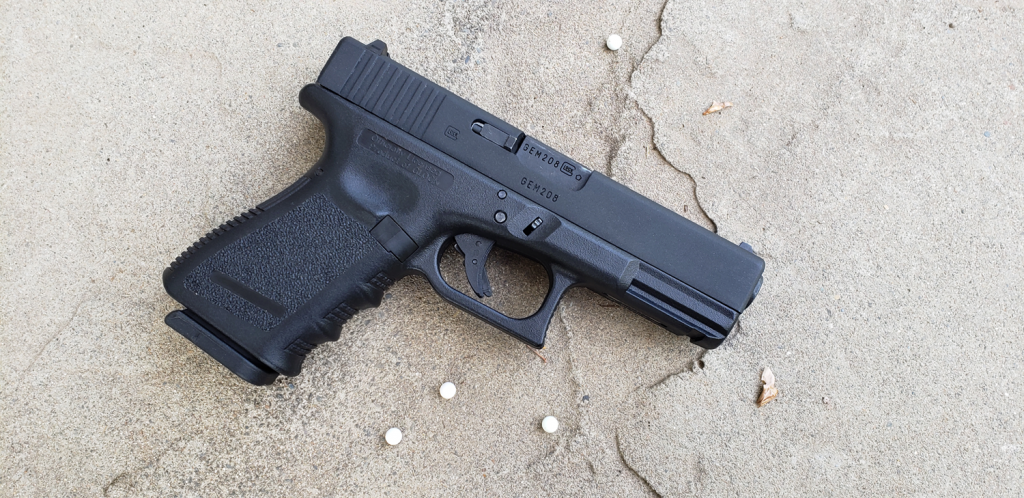 Among the more hotly anticipated (or controversial, depending on who you talk to) Airsoft releases this past year or so, has been the Elite Force Glock 19 manufactured by VFC. What sets this particular Glock apart from the many others that have stepped before it is that it is an officially licensed replica. For US based players in particular, this presents itself as a much more accessible Glock product, as obtaining one in the past has not been without certain difficulties. Some might remember the massive blowback from Glock themselves quite a few years ago, and the myriad cease and desist letters that were sent to manufacturers, distributors and stores alike that were dealing in Glock replicas. Needless to say, if you wanted an accurately ‘traded’ Glock replica, you generally had to ship it into the US in parts and pieces. The alternative was to simply accept any number of clones and copies that disused trades or even made significant alternations on the physical appearance of the Glock design itself.
Among the more hotly anticipated (or controversial, depending on who you talk to) Airsoft releases this past year or so, has been the Elite Force Glock 19 manufactured by VFC. What sets this particular Glock apart from the many others that have stepped before it is that it is an officially licensed replica. For US based players in particular, this presents itself as a much more accessible Glock product, as obtaining one in the past has not been without certain difficulties. Some might remember the massive blowback from Glock themselves quite a few years ago, and the myriad cease and desist letters that were sent to manufacturers, distributors and stores alike that were dealing in Glock replicas. Needless to say, if you wanted an accurately ‘traded’ Glock replica, you generally had to ship it into the US in parts and pieces. The alternative was to simply accept any number of clones and copies that disused trades or even made significant alternations on the physical appearance of the Glock design itself.
Average retail price for the Elite Force Glock is $169 with spare mags clocking in around $44. This puts it slightly north of a comparable new Tokyo Marui Glock replica in cost. But starts to even out once you factor in overseas shipping. Keep in mind some of that extra padding is undoubtedly wrapped up in licensing. For anyone who actively buys officially licensed products (*cough* Lego Star Wars *cough*) you’re already well familiar with the cost of doing business. C’est la vie.
I won this pistol through a raffle drawing at a local Pegasus Airsoft event; the pistol itself was generously donated by ThunderKissNW.
This will not be so much a performance review as it is a detailing of the inner parts and workings of the gun. I was pretty dissatisfied with the lack of concrete details surrounding this pistol, so I decided to fully disassemble it to see for myself what’s inside.
Exterior Features
This particular replica is reputedly a true 1:1 of the real steel Gen. 3 Glock 19 and it certainly feels that way. Unlike the TM G17 models, which are actually modeled around the larger G21 in size, the EF G19 actually fits a G19 holster perfectly. The slide is nicely finished out in a smooth matte black finish, though the finish doesn’t quite match up to the real thing.
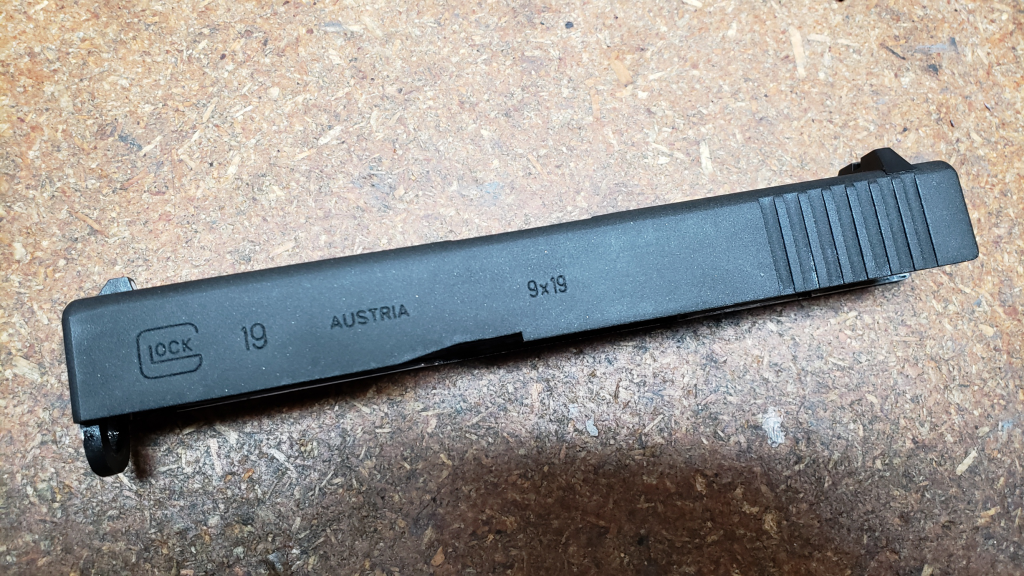
There are various trades found throughout, including serial numbers, some of which are presumably unique to each replica. Of note, however, the serial number on the slide does not match that found on the lower.
The lower grip frame feels sturdy and does not flex when squeezed tightly in the hand. The light rail presents a very tight fit for real steel accessories, such as the Surefire X300U, and you might struggle mightily to remove it after installing it. I did not experience any issue with binding on the slide while running the gun with the Surefire installed.
The right side of the frame departs from the real steel with a few small differences, namely the “Officially Licensed Product of Glock” and a curious blank strip on the lower end of the grip which I believe is missing some text and is actually borrowed from the Gen. 4 frame.
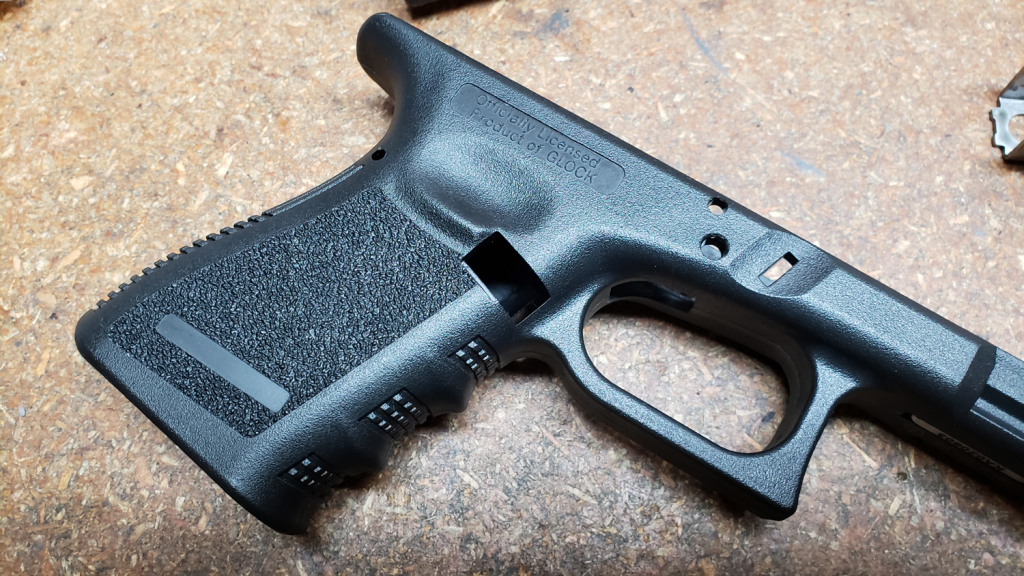
The underside of the trigger guard is engraved with a warning label. For those who are curious, the engraving seems to be quite shallow, and I suspect it would be easily removed. It’s not very noticeable in most lighting conditions for that matter. A serial number plate is found on the bottom of the rail segment and appears to accurately replicate the original.
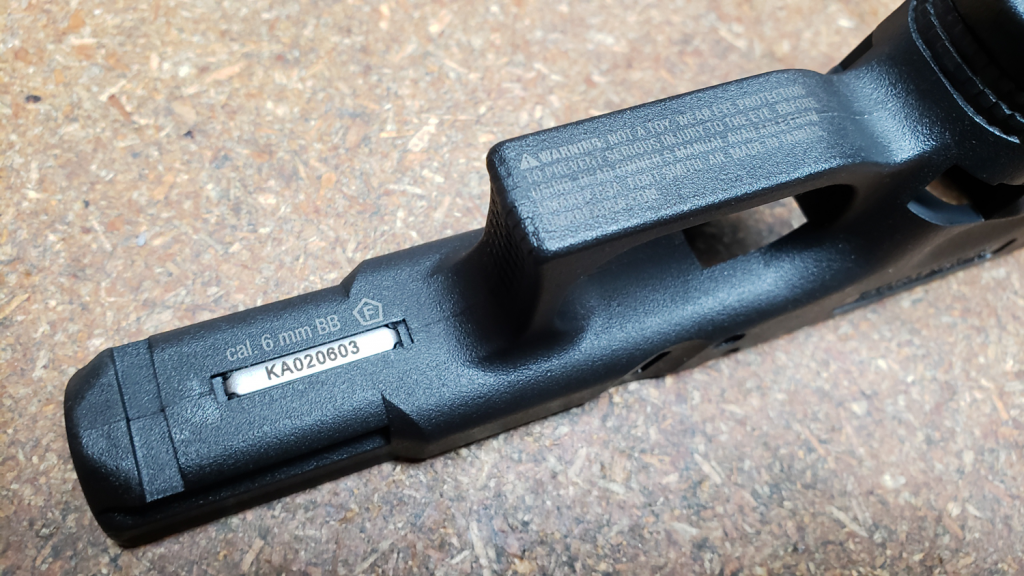
The stippling is nicely done – not too rough, not too slippery. The magazine release is nice and positive. Magazines drop free easily, and there is no binding or tight spots.
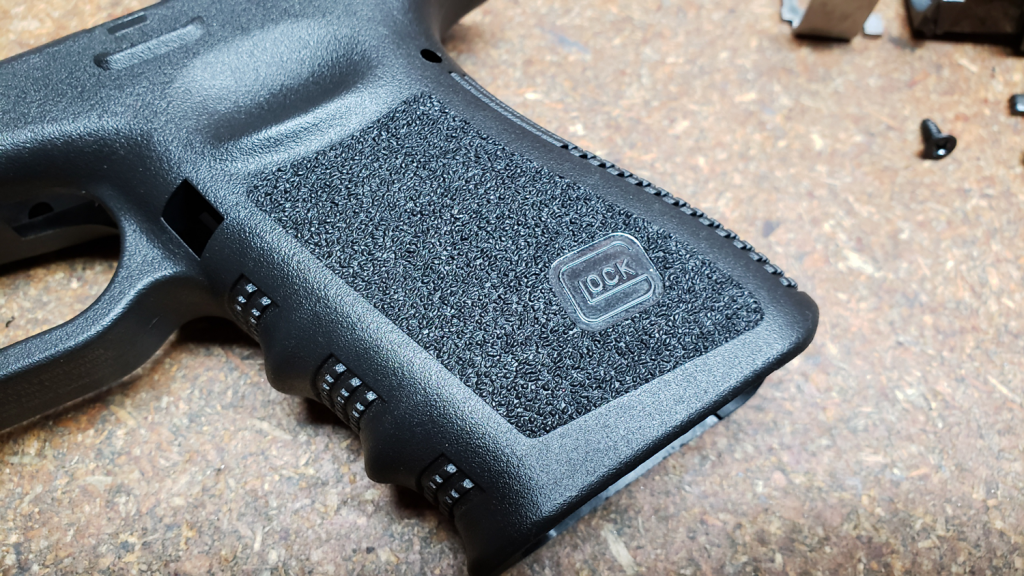
Coming from the HK45 / P30 / VP9 world, I admit that the Glock grip frame feels a bit like a ungainly brick and just points wrong for me. Similarly, I find myself struggling with the magazine release. With the HK series I’m used to just swiping my trigger finger straight down to release a magazine, no shifting of the grip required. Whereas with the Glock I have to shift my grip around to actuate the magazine release. A training issue, no doubt.
The magazines are nicely done, featuring full Glock trades and even small details such as the round count indicators on the back. I find it a little inconvenient to have to slide the magazine plate forward to fill the mag, so I may mod this by drilling a hole through the plate. Capacity is 19 rounds, which is 4 more shots than you get with the real magazine. WE magazines are fully compatible with this gun.
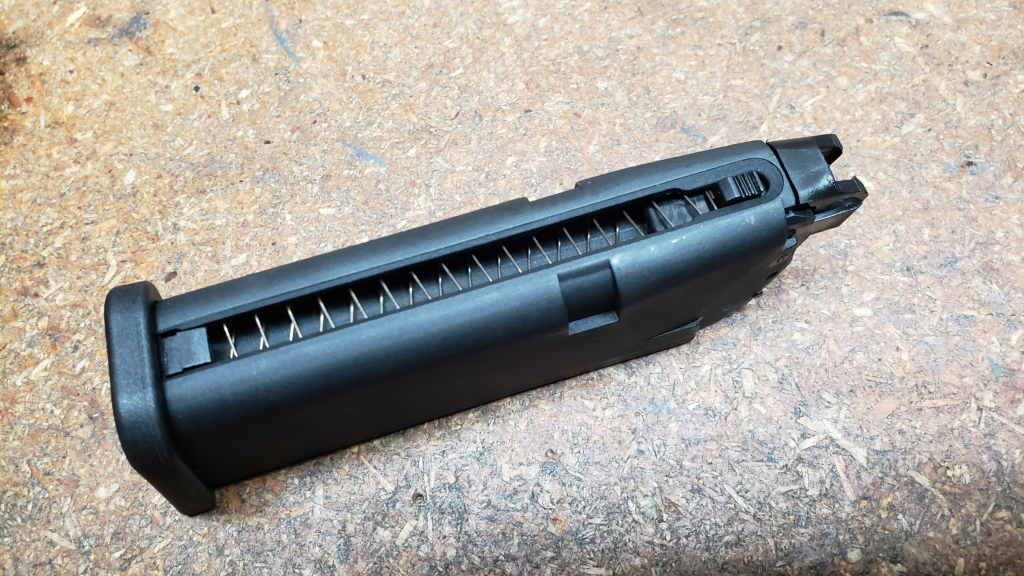
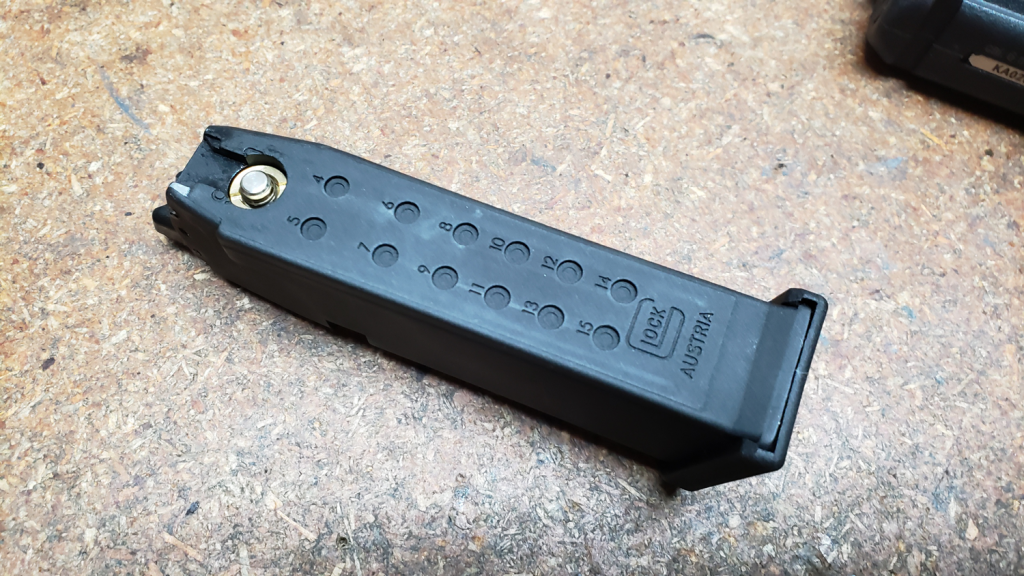
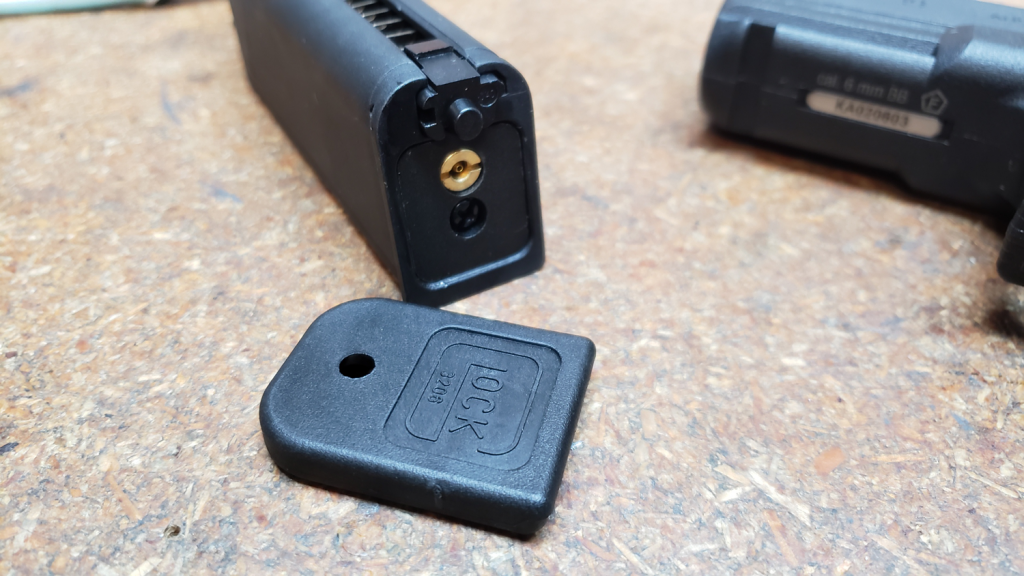
The rear sight is a dovetail setup that is held in place via friction. To be honest, I find it very easy to press the sight off with just my fingers. I would advise for long term use to glue the rear into place to keep it from coming off. The front is retained via a small screw. I do not know at present what compatibility this has with aftermarket sights or even real steel sights.
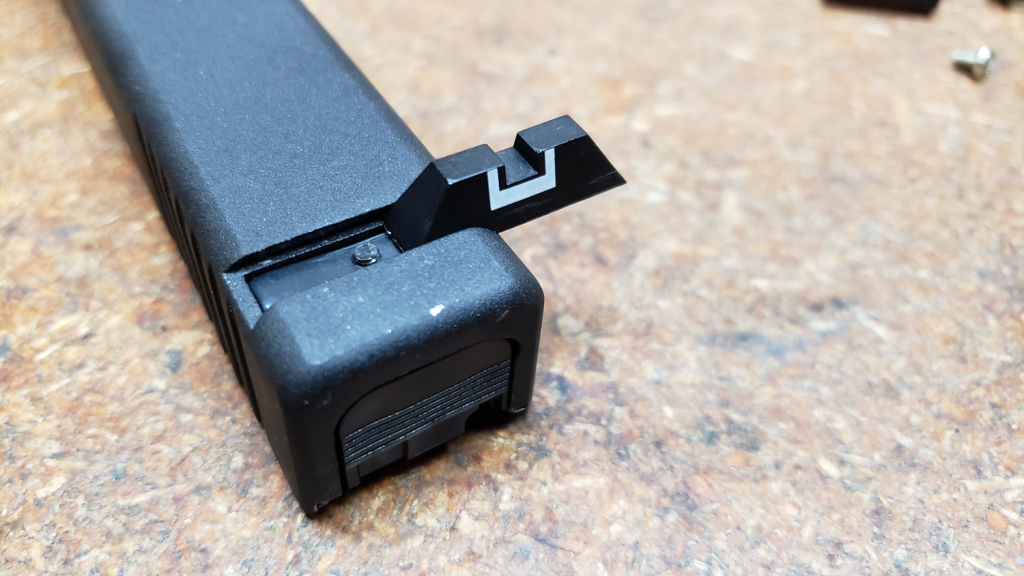
Internal Features
Basic field stripping of this pistol is quite easy. Safety Queens will be happy to know that unlike the real Glock, you don’t even have to pull the trigger to remove the slide. Simply pull down on both sides of the slide lock and pull the slide forward and off the the rails.
The barrel assembly is removed by first pulling free the recoil rod. This is closer in resemblance that found in the Gen. 4 Glock, and has a set of dual springs. The rod itself is plastic.
The outer barrel assembly is made from aluminum, and has the same matte finish as the slide. The right side of the hood is engraved with Glock trades and a serial number. In stock configuration, this comes with a threaded plastic orange tip that is also glued in place. This can be removed by boiling the barrel for several minutes and then twisting the cap off with some pliers. I do not know what the internal thread pitch is of the barrel. If I had to guess, I’d say 11 or 12mm perhaps.
At present, Helix is currently the only manufacturer making threaded outer barrels for these. I have read that TM outer barrels will fit with some minor modification, however.
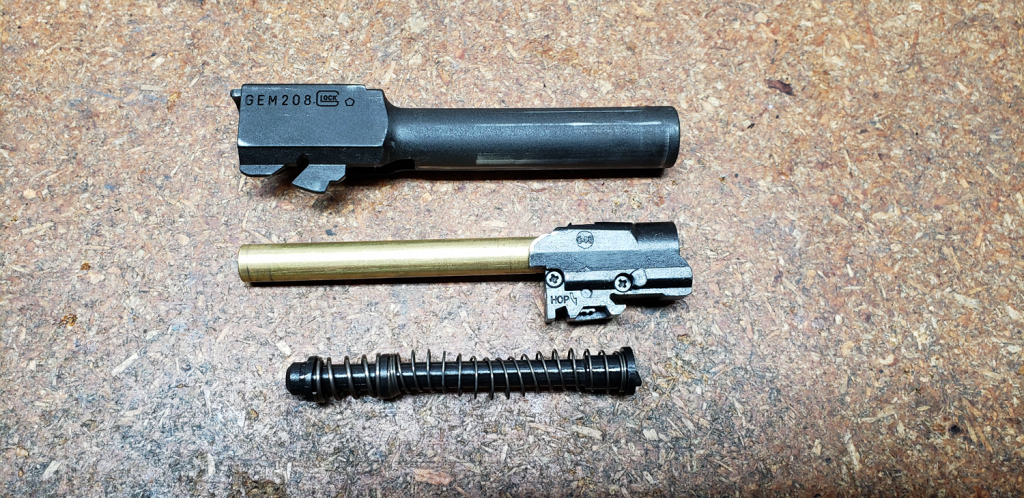
The inner barrel and hop up chamber simply slide out the back of the outer barrel. The barrel and bucking itself are TM compatible, as is the hop up wheel and various small hop up components. The hop up chamber body itself is proprietary, but replacement parts are presently available.
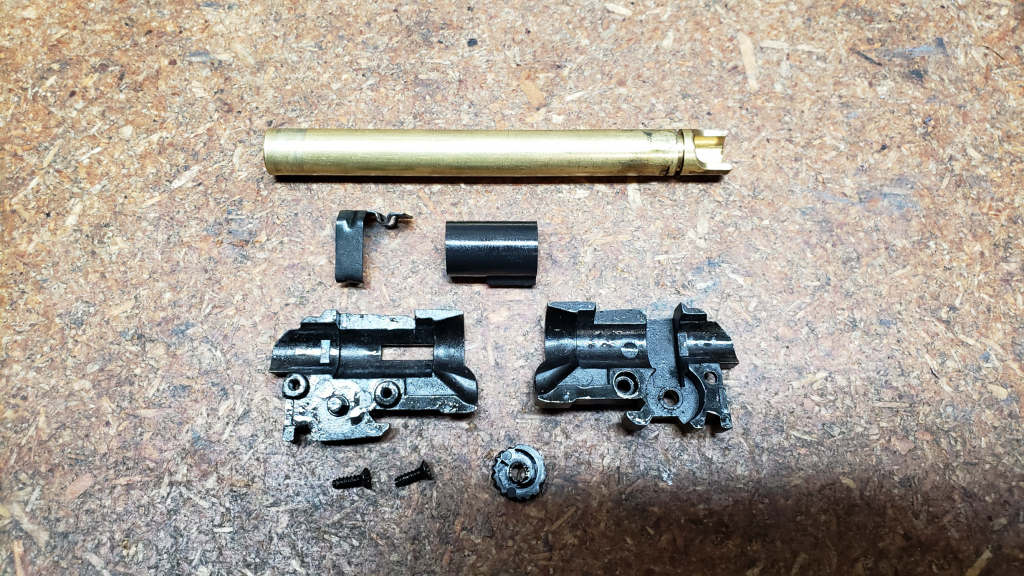
The air nozzle and housing is essentially a TM G18C setup. Unlike the TM version, however, this one is made from metal. The nozzle return is assisted by a single spring, which seems a bit on the weak side to me. I’ve noted that it seems a bit sticky when operated manually, which may be due to a weak spring and / or drag from the metal housing. I suspect a little polishing on the housing will smooth it up some. It does not present itself as an issue when firing the gun, though.

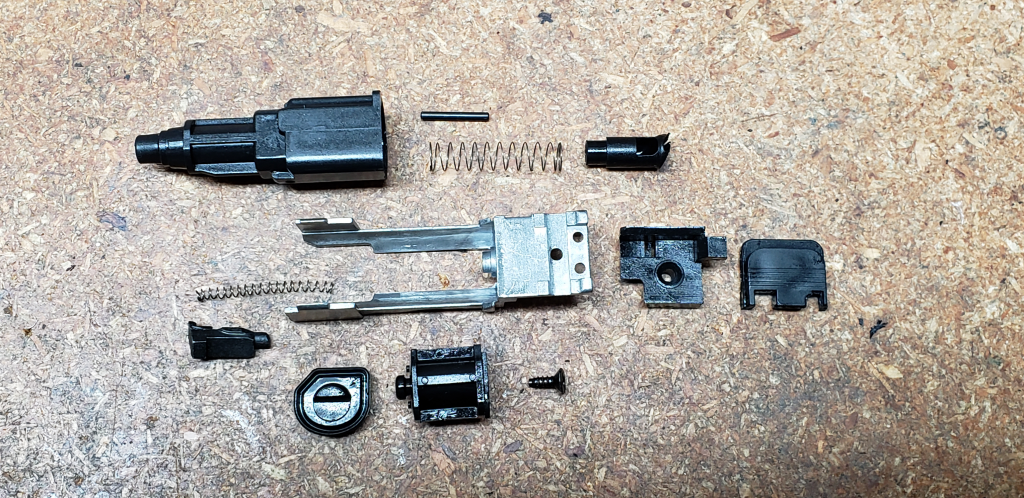
The frame is slightly more complex, but if you’re at all versed with the real Glock teardown, some of the disassembly steps will be familiar.
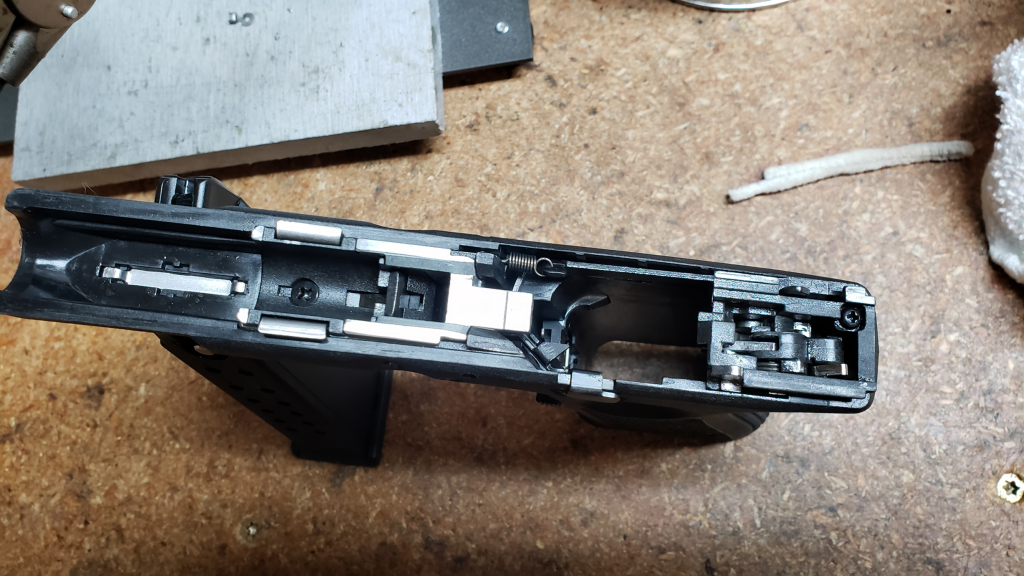
Starting with the locking block, press the two pins out from the right side of the frame. The slide release and spring will pop free, as will the trigger bar return spring. The locking block can then be pulled straight up and out.
I recommend leaving the lone screw located in front of the locking block in place in order to more easily remove the slide lock. This is accomplished by depressing the flat spring and sliding it out either the left or right side. After this step, you can remove the screw and the rest of the housing will slide free.
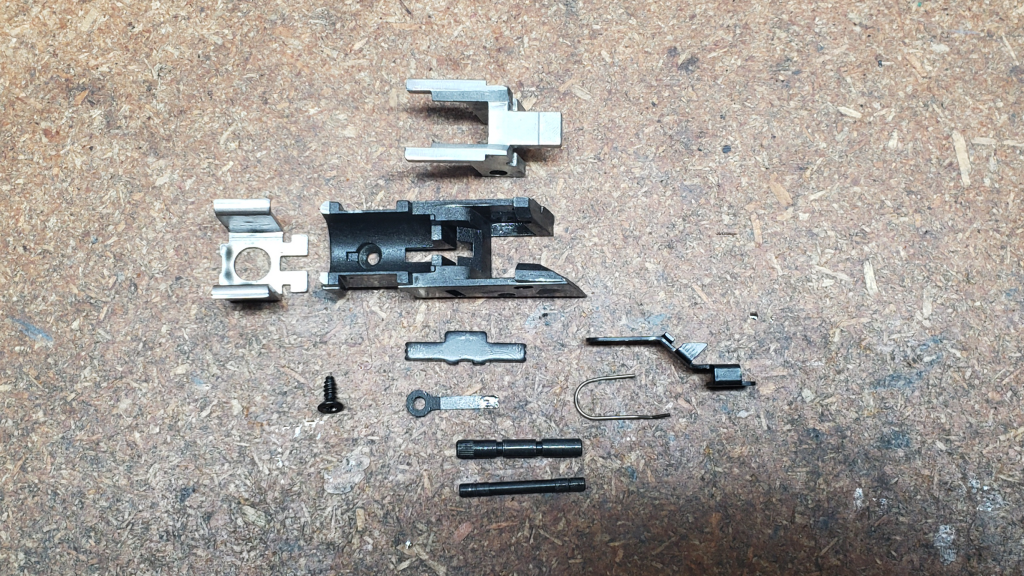
The slide release lever appears remarkably like the real steel version, and I would almost think this piece is compatible with real steel parts. Update 12/20/18: I have confirmed a real steel Glock slide release fits perfectly. Unlike the real Glock, it’s actually functionally usable in it’s stock form too, and doesn’t require a herculean effort to drop the slide.
On my example, I discovered the locking block surface was too high and was a significant contributor to slide drag. it actually sat higher than the slide rails themselves, and was binding on the underside of the slide, causing the cylcling to be sluggish and not at all smooth. A little bit of file work fixed this easily enough.
At this point, the trigger is still essentially held captive by the fire control group chassis. This is removed by taking out the single screw and push pin located on the backstrap of the grip. Sliding this straight up and out will free up the trigger and trigger bar. I do not know what kind of compatibility there is with aftermarket triggers or just the trigger shoe itself.
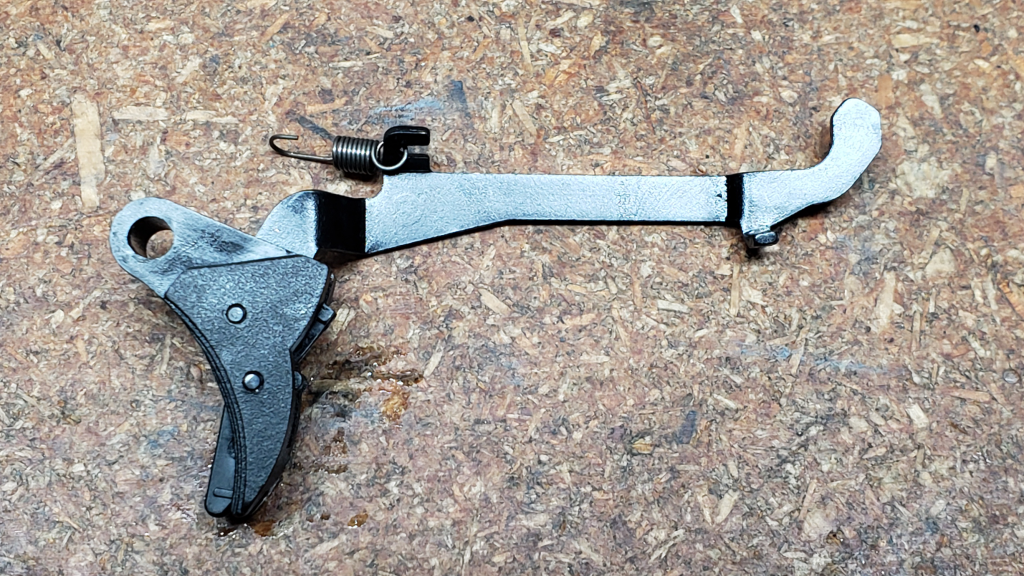

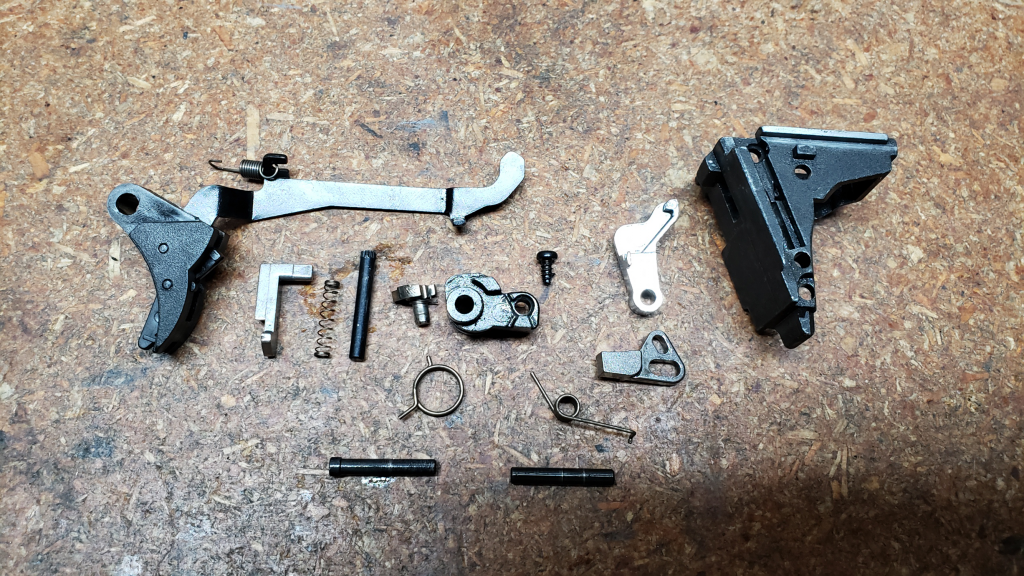
Some of these parts resemble TM parts, but without comparing them side by side, I can’t be 100% sure of their compatibility.
The last part to remove is the magazine release and spring. This is very simple, and by unhooking the spring from the magazine release you can slide it out the right side of the frame. The magazine release has a metal catch molded in, which is a nice touch as the magazines are also metal and should make this part more durable than the full polymer magazine release found in the real steel Glock. Granted, the real steel version uses polymer magazines.

Overall, disassembly of the frame was quite easy and did not present any unique challenges. The only tools really required are a small punch and screwdriver. A dental pick can be helpful for reassembly of the valve striker spring. With a little familiarity under your belt, you could easily do a full teardown in under 10 minutes – though this is hardly necessary in the course of normal maintenance.
Final Notes
I was impressed with how easy it is to fully disassemble this pistol. I am also pleasantly surprised with the the trigger pull too. It feels very much like a real Glock with a 3.5lbs Ghost Connector fitted… with an albeit very Glock-like “break”, such as it is. It’s quite unlike my KWA’s which basically have almost no takeup and just roll through the trigger pull. With the EF Glock, it’s easy to stage the trigger.
Less impressive is the relatively poor stock accuracy, which I largely attribute to a below-average bucking. This is not an uncommon phenomena with stock guns though. With the exception of the TM, very few stock pistols have quality buckings installed from the factory. I consider them “placeholders”, essentially.
Installing a Maple Leaf 60* Autobot improved accuracy substantially, as did experimenting with a Maple Leaf Crazy Jet I stole from my VFC VP9 (despite it being a hair long). I have been told the Poseidon barrels are better quality, so I figure now is as good a time as any to test it out, and have ordered up a Poseidon inner barrel and Maple Leaf bucking to replace the stock components.
Perhaps my biggest complaint is the locking block issue. Out of the box, this pistol had a very sluggish slide in addition to being heavily over-lubricated from the factory. It struggled to meander through a single magazine, and if you rode the slide manually you could cause it to stick partially open. The recoil was very weak. For most this would be a valid excuse to seek a warranty claim. As a tech, I would rather fix it myself than wait on the often laborious and time consuming warranty claim process. I also believe I can ‘make it better’ anyway, so to speak.
After filing down the height of the locking block and polishing the slide rails both on the frame and slide, it operates a lot more smoothly now. I was able to achieve 4 full magazines on a single propane fill, with the slide fully locking back at the end of every empty mag. The felt recoil has greatly increased as well. It would be wrong of me to say that the locking block issue is representative of all Elite Force G-Series pistols, as this is really only a sample size of one – and thus far is the only one I’ve had exposure to.
In closing, I believe this pistol certainly has promise and I look forward to running it hard for the next year. The next review on this pistol will cover some upgrades I will be installing and additional compatibility findings.
